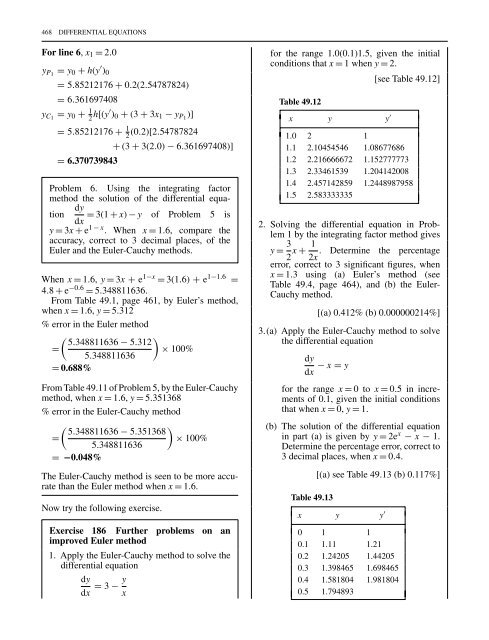differential equation
Create successful ePaper yourself
Turn your PDF publications into a flip-book with our unique Google optimized e-Paper software.
468 DIFFERENTIAL EQUATIONS<br />
For line 6, x 1 = 2.0<br />
y P1 = y 0 + h(y ′ ) 0<br />
= 5.85212176 + 0.2(2.54787824)<br />
= 6.361697408<br />
y C1 = y 0 + 1 2 h[(y′ ) 0 + (3 + 3x 1 − y P1 )]<br />
= 5.85212176 + 1 2 (0.2)[2.54787824<br />
= 6.370739843<br />
+ (3 + 3(2.0) − 6.361697408)]<br />
Problem 6. Using the integrating factor<br />
method the solution of the <strong>differential</strong> <strong>equation</strong><br />
= 3(1 + x) − y of Problem 5 is<br />
dy<br />
dx<br />
y = 3x + e 1 − x . When x = 1.6, compare the<br />
accuracy, correct to 3 decimal places, of the<br />
Euler and the Euler-Cauchy methods.<br />
When x = 1.6, y = 3x + e 1−x = 3(1.6) + e 1−1.6 =<br />
4.8 + e −0.6 = 5.348811636.<br />
From Table 49.1, page 461, by Euler’s method,<br />
when x = 1.6, y = 5.312<br />
% error in the Euler method<br />
( )<br />
5.348811636 − 5.312<br />
=<br />
× 100%<br />
5.348811636<br />
= 0.688%<br />
From Table 49.11 of Problem 5, by the Euler-Cauchy<br />
method, when x = 1.6, y = 5.351368<br />
% error in the Euler-Cauchy method<br />
( )<br />
5.348811636 − 5.351368<br />
=<br />
× 100%<br />
5.348811636<br />
= −0.048%<br />
The Euler-Cauchy method is seen to be more accurate<br />
than the Euler method when x = 1.6.<br />
Now try the following exercise.<br />
Exercise 186 Further problems on an<br />
improved Euler method<br />
1. Apply the Euler-Cauchy method to solve the<br />
<strong>differential</strong> <strong>equation</strong><br />
dy<br />
dx = 3 − y x<br />
for the range 1.0(0.1)1.5, given the initial<br />
conditions that x = 1 when y = 2.<br />
[see Table 49.12]<br />
Table 49.12<br />
x y y ′<br />
1.0 2 1<br />
1.1 2.10454546 1.08677686<br />
1.2 2.216666672 1.152777773<br />
1.3 2.33461539 1.204142008<br />
1.4 2.457142859 1.2448987958<br />
1.5 2.583333335<br />
2. Solving the <strong>differential</strong> <strong>equation</strong> in Problem<br />
1 by the integrating factor method gives<br />
y = 3 2 x + 1 . Determine the percentage<br />
2x<br />
error, correct to 3 significant figures, when<br />
x = 1.3 using (a) Euler’s method (see<br />
Table 49.4, page 464), and (b) the Euler-<br />
Cauchy method.<br />
[(a) 0.412% (b) 0.000000214%]<br />
3.(a) Apply the Euler-Cauchy method to solve<br />
the <strong>differential</strong> <strong>equation</strong><br />
dy<br />
dx − x = y<br />
for the range x = 0tox = 0.5 in increments<br />
of 0.1, given the initial conditions<br />
that when x = 0, y = 1.<br />
(b) The solution of the <strong>differential</strong> <strong>equation</strong><br />
in part (a) is given by y = 2e x − x − 1.<br />
Determine the percentage error, correct to<br />
3 decimal places, when x = 0.4.<br />
Table 49.13<br />
[(a) see Table 49.13 (b) 0.117%]<br />
x y y ′<br />
0 1 1<br />
0.1 1.11 1.21<br />
0.2 1.24205 1.44205<br />
0.3 1.398465 1.698465<br />
0.4 1.581804 1.981804<br />
0.5 1.794893










